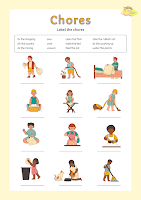Learning Responsibility Worksheet for Kids
 |
| Chores Fun: Learning Responsibility Worksheet |
Teaching children the value of responsibility is essential, and one of the best ways to do so is through daily chores. Our engaging "Chores Fun" worksheet is designed to make learning about household tasks an enjoyable experience for kids.
This interactive worksheet introduces children to various household chores, helping them understand the importance of contributing to the family. Through activities such as identifying, matching, and organizing common tasks like sweeping, making the bed, or tidying up, kids learn in a hands-on way.
Not only does this worksheet encourage participation in daily responsibilities, but it also fosters teamwork and the development of good habits. By understanding their role within the family, children can feel a sense of accomplishment and pride in their work.
Designed to be both educational and fun, this chore worksheet is perfect for building life skills early on. Whether used at home or in a classroom setting, it provides an excellent opportunity for kids to understand how they can help and become active members of their households. Download the worksheet today and start building responsible habits with your little ones!
This engaging worksheet helps children learn about daily chores and the importance of responsibility. Through fun activities, students will identify, match, and organize various household tasks, encouraging them to understand and participate in helping around the home. Perfect for building good habits and teamwork skills.

Comments
Post a Comment